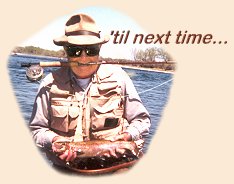Q.
From STUART LENT: During flooding, when streams
and lakes overrun their banks, what happens to
the fish and are there any changes to the way
to fish these streams and lakes?
A.
I'll handle the first part of this, but leave
the fishing strategy to those folks that field
those kinds of questions.
Flooding in streams is usually of more consequence
to fish than flooding of lakes. In the latter, it
is mostly a case of fish in the lake following the
overflowing water. Then it is a matter of where
they end up when the water recedes. If they find
there way into a river bed and can live there, they
might survive. If they get left stranded, they either
die when the water disappears or if stranded in pools,
may die when the water heats up to lethal temperatures.
Survival of fish, or any other aquatic organisms
for that matter, during floods in streams is a
much greater traumatic episode and depends on
several factors, two of the most important being
the severity of the flood and the presence or
absence of refuges or obstructions in the water
where they can find shelter from the force of
the flooding water.
It is quite surprising to find that fish and other
organisms can survive floods which one would guess
they had no chance in. Most of this is related to
the fact that large rocks, trees, still waters or
eddies at the edge of the stream, depressions in
the bottom, and other such structures provide a
refuge so that the organisms can escape the force
of the water current. Of course this won't work
if the flood is of such force that it moves these
objects and thoroughly scours the bottom. Then,
the organisms are either displaced downstream or
killed. As I said, survival can be remarkable.
I've studied a small cold-desert spring stream
that normally is about 3 ft. wide and 4 inches deep.
In certain winters when chinook winds rapidly melt
the snow, the stream grows almost instantly to 60 ft
wide and about 12 feet deep - a real arroyo gully-washer!
Yet within a day or so of the stream returning to normal
flows, which is very quickly, you can find populations
of chironomid larvae and damselfly larvae in the stream;
there are no fish. It's hard to believe anything could
survive.
Although I'd rather defer the "how to fish" part of the
question to those who answer these questions, a couple
of things are obvious. First, if you're trying to fish
them while they're flooding - be careful. Second,
water conditions will likely be disturbed with the
water quite turbid from suspended sediments. Thus,
you need a lure that is highly visible and one fished
where they fish are - on the bottom or behind obstructions.
Third, the fish may be more concerned with living than
feeding, so probably won't be feeding regularly.
~ C. E. (Bert) Cushing, aka Streamdoctor
105 W. Cherokee Dr.
Estes Park, CO 80517
Phone: 970-577-1584
Email: streamdoctor@aol.com
 The 'Stream Doctor' is a retired professional stream ecologist and
author, now living in the West and spending way too much time
fly-fishing. You are invited to submit questions relating to
anything stream related directly to him for use in this Q & A Feature
at streamdoctor@aol.com.
The 'Stream Doctor' is a retired professional stream ecologist and
author, now living in the West and spending way too much time
fly-fishing. You are invited to submit questions relating to
anything stream related directly to him for use in this Q & A Feature
at streamdoctor@aol.com.
|

 The 'Stream Doctor' is a retired professional stream ecologist and
author, now living in the West and spending way too much time
fly-fishing. You are invited to submit questions relating to
anything stream related directly to him for use in this Q & A Feature
at
The 'Stream Doctor' is a retired professional stream ecologist and
author, now living in the West and spending way too much time
fly-fishing. You are invited to submit questions relating to
anything stream related directly to him for use in this Q & A Feature
at